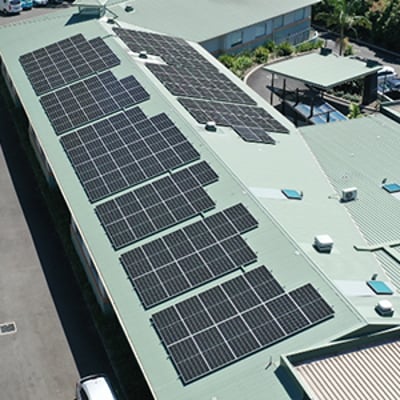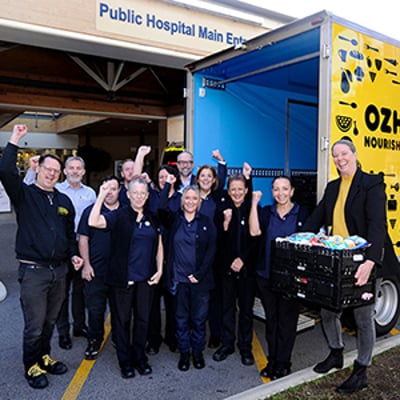Sustainability matters at Ramsay
At Ramsay, sustainability is part of who we are. Our people, patients and doctors care deeply about creating a healthier future.
We have a global sustainability strategy called Ramsay Cares. Our people and our business are focused on three pillars of sustainability:
- Caring for our people.
- Caring for our planet.
- Caring for our community.
We’ve set bold targets, including becoming a net zero greenhouse gas emissions business by 2040. But real progress comes from the everyday actions of our people. Across Australia, our teams are leading and inspiring change in practical, meaningful ways.
Caring for our people
At Ramsay, we care for our patients, our partners and each other. Our culture attracts people who are driven to support, heal and lead with purpose.
‘Nan’ Tina Garlett was one of Ramsay Health Care’s first Aboriginal Liaison Officers, based at Joondalup Health Campus. An experienced cultural support worker, Tina brings deep cultural knowledge, empathy and professional skill to her role.
She supports Aboriginal and Torres Strait Islander patients and their families through emotional, social and cultural care, helping them feel safe, respected and understood during their hospital journey.
Beyond her day-to-day work, Tina has completed multiple Ramsay training programs and actively mentors others. She plays a key role in the Marr Mooditj cadetship program, helping guide and empower the next generation of Aboriginal health professionals.

When Southport Private Hospital Psychologist and Allied Health Team Leader Cas Mastrone ran a Mental Health First Aid (MHFA) training session at her hospital, the response was overwhelmingly positive.
It was such a success that Cas was invited to lead Ramsay’s national MHFA program. Since then, hundreds of staff have completed the training, building their confidence to recognise the signs of distress and support colleagues when it matters most.
The program has created a growing network of mental health champions across Ramsay — fostering a culture where people feel seen, supported and safe to speak up.

Mt Wilga Private Rehabilitation Hospital’s Director of Allied Health, Jennifer King, led the creation of a beautifully designed outdoor mobility garden.
The space offers more than just a peaceful retreat for patients, families and staff. It’s also a purpose-built environment that supports therapy and rehabilitation.
With accessible paths, sensory elements and functional design features, the garden blends comfort with clinical benefit, helping patients regain confidence and independence in a natural setting.

Caring for our planet
Health care depends on energy, materials and resources. As Australia’s largest private hospital network, we’re committed to reducing our environmental impact and our people are driving practical change every day.
With large buildings and high energy needs, hospitals are well-placed to benefit from solar power.
Ramsay has been steadily rolling out rooftop solar systems across dozens of hospitals as part of our commitment to becoming a net zero greenhouse gas emissions business by 2040.
These installations help reduce electricity costs and lower emissions without disrupting patient care. To date, we’ve invested millions of dollars in solar infrastructure, one of the largest commitments to renewable energy in Australia’s private hospital sector.

Desflurane, a commonly used anaesthetic gas, has a significant environmental impact, with a global warming potential thousands of times greater than carbon dioxide.
In 2022, Ramsay Australia set a bold target to reduce use of desflurane to less than 5% of total anaesthetic gas use, with team members like Hollywood anaesthetist Dr Chris Mitchell leading the charge.
Since then, hospitals across our network have reviewed practices, engaged anaesthetists and introduced lower-emission alternatives.
Today, almost 60% of Ramsay Australia hospitals have achieved the target.

Since 2017, Joondalup Health Campus has partnered with food rescue charity OzHarvest to donate thousands of unopened, packaged food items left on patient trays. Instead of ending up in landfill, this nutritious food now goes to people experiencing food insecurity in the local community.
The partnership is a simple but powerful way to reduce waste and support those doing it tough. It reflects Ramsay’s commitment to making a positive impact beyond hospital walls by working with community organisations to address real social needs. Our teams at Joondalup have embraced the initiative, knowing that small changes in daily practice can add up to meaningful outcomes for people in need.

Registered Nurse Katie Foy saw how many unused medical items were going to waste and decided to do something about it. She launched Save Our Supplies (SOS), a program at North West Private Hospital that collects excess medical equipment and sends it to hospitals and communities in need, both in Australia and overseas.
SOS has not only reduced clinical waste but also extended the life of valuable resources that would otherwise go unused. Katie’s work is a powerful example of how frontline staff can drive sustainability and social impact, supporting better health outcomes while protecting the environment.

Caring for our community
Supporting people’s health and wellbeing includes building stronger, more connected communities. Across Ramsay, our teams work with local partners and organisations to create lasting, meaningful change because when communities thrive, so do the people in them.
Many Ramsay employees take part in the Ramsay Health Care Triathlon Pink series — a fun and inclusive event that raises funds for the National Breast Cancer Foundation.
Among the most enthusiastic supporters is the team from John Flynn Private Hospital, which rallies more than 100 participants each year.
Ramsay employees, family members and friends come together to swim, ride and run in support of breast cancer research, proudly wearing pink and showing their commitment to a cause that touches many lives.

Through Ramsay’s annual Charity Challenge program, staff are sponsored to volunteer in developing countries, donating medical supplies and supporting local healthcare services.
Frances Perry House midwives Christine Murphy, Eliza Strauss, Steph Tsesmetzis and Megan Whittle took part in the program by spending four weeks in Arusha, Tanzania.
Working in a high-risk labour ward, they cared for patients, assisted with births and shared their knowledge with local midwives and doctors. Their contribution helped build local capacity while offering vital support to a busy, under-resourced maternity service.

Ramsay’s people often go above and beyond — not only in their clinical roles but in their contribution to communities around the world.
At Greenslopes Private Hospital, urogynaecologists Professor Judith Goh AO and Professor Hannah Krause AO have spent decades volunteering in communities across Asia and Africa, treating women with complex and often painful gynaecological conditions.
They have performed hundreds of procedures that would otherwise be out of reach for these patients, restoring comfort, dignity and quality of life. Both have been recognised as Officers of the Order of Australia for their outstanding humanitarian work.

Find out more
Want to learn more about the Ramsay Way, our sustainability initiatives and achievements? Head to our global sustainability page.

Ramsay Newsroom
Stay up-to-date with hospital news, developments, research highlights and innovation.